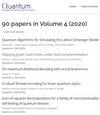Entanglement buffering with two quantum memories
IF 5.1
2区 物理与天体物理
Q1 PHYSICS, MULTIDISCIPLINARY
引用次数: 0
Abstract
Quantum networks crucially rely on the availability of high-quality entangled pairs of qubits, known as entangled links, distributed across distant nodes. Maintaining the quality of these links is a challenging task due to the presence of time-dependent noise, also known as decoherence. Entanglement purification protocols offer a solution by converting multiple low-quality entangled states into a smaller number of higher-quality ones. In this work, we introduce a framework to analyse the performance of entanglement buffering setups that combine entanglement consumption, decoherence, and entanglement purification. We propose two key metrics: the availability, which is the steady-state probability that an entangled link is present, and the average consumed fidelity, which quantifies the steady-state quality of consumed links. We then investigate a two-node system, where each node possesses two quantum memories: one for long-term entanglement storage, and another for entanglement generation. We model this setup as a continuous-time stochastic process and derive analytical expressions for the performance metrics. Our findings unveil a trade-off between the availability and the average consumed fidelity. We also bound these performance metrics for a buffering system that employs the well-known bilocal Clifford purification protocols. Importantly, our analysis demonstrates that, in the presence of noise, consistently purifying the buffered entanglement increases the average consumed fidelity, even when some buffered entanglement is discarded due to purification failures.利用两个量子存储器实现纠缠缓冲
量子网络在很大程度上依赖于分布在遥远节点上的高质量纠缠量子比特对(称为纠缠链路)的可用性。由于存在随时间变化的噪声(也称为退相干),保持这些链路的质量是一项极具挑战性的任务。纠缠净化协议通过将多个低质量纠缠态转换为数量较少的高质量纠缠态,提供了一种解决方案。在这项工作中,我们引入了一个框架来分析纠缠缓冲设置的性能,该框架结合了纠缠消耗、退相干和纠缠净化。我们提出了两个关键指标:可用性(即纠缠链路存在的稳态概率)和平均消耗保真度(量化消耗链路的稳态质量)。然后,我们研究了一个双节点系统,其中每个节点都拥有两个量子存储器:一个用于长期纠缠存储,另一个用于纠缠生成。我们将这种设置建模为连续时间随机过程,并推导出性能指标的分析表达式。我们的研究结果揭示了可用性与平均消耗保真度之间的权衡。我们还对采用著名的双局部克利福德净化协议的缓冲系统的这些性能指标进行了约束。重要的是,我们的分析表明,在存在噪声的情况下,即使由于净化失败而丢弃了一些缓冲纠缠,持续净化缓冲纠缠也会提高平均消耗保真度。
本文章由计算机程序翻译,如有差异,请以英文原文为准。
求助全文
约1分钟内获得全文
求助全文
来源期刊

Quantum
Physics and Astronomy-Physics and Astronomy (miscellaneous)
CiteScore
9.20
自引率
10.90%
发文量
241
审稿时长
16 weeks
期刊介绍:
Quantum is an open-access peer-reviewed journal for quantum science and related fields. Quantum is non-profit and community-run: an effort by researchers and for researchers to make science more open and publishing more transparent and efficient.
 求助内容:
求助内容: 应助结果提醒方式:
应助结果提醒方式:


